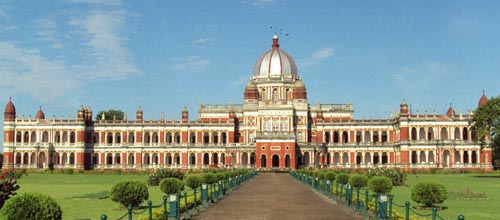Cooch Behar Palace

Information on Cooch Behar Palace (Cooch Behar, West Bengal) - History & Architecture
Cooch Behar Palace is the key attraction and a legendary milestone of Cooch Behar city of West Bengal. Cooch Behar Palace is also known as Victor Jubilee Palace. This wonderful palace was created in the year 1887 AD during the sovereignty of King Nripendra Narayana. Presently the palace is under the supervision of Archaeological Survey of India.
Cooch Behar Palace Architecture
Cooch Behar Palace was created according to the structure of Buckingham Palace of London. The design of the palace is a brilliant example of standard Italian architectural style. It is a brick made double storey building which encompass an area of about 51,309 square feet. The entire structure of the palace is about 12 meter long and 90 meter wide. Cooch Behar Palace is bordered by sequence of arcaded verandas with the wharves organised in single and dual rows. The palace is marginally projected in southern and northern sides. In the center of the palace, there is a porch which is the key gateway to the building. The anterior of Cooch Behar Palace comprises series of arcs characterised by delicate design of narrow and wide piers to contain single and dual pillars correspondingly.
The central hall of Cooch Behar Palace possesses a pleasingly formed metal roof which is topped by cylinder-shaped ventilator. The roof is about 124 feet high from the ground and is based on resurgence architectural style. The interior of the roof is engraved in stepped designs and bordered by small sophisticated gallery with about 12 windows at the base. The surface of Cooch Behar Palace is designed with multi-coloured designs. It comprises numerous halls encompassing dining hall, billiard hall and library hall. Furthermore, the palace also has number of rooms such as dressing room, bed room and drawing room.
In the first floor of the palace, there is a big mansion namely 'Durbar Hall'. It is the key hall of the museum which demonstrate royal emblems. At present, most of the objects and exquisite things of these rooms and halls are lost. The remaining objects of the palace are situated in the museum. Moreover, among various halls of Cooch Behar Palace, only few are viewable for public.
Cooch Behar Palace History
Cooch Behar Palace has rich royal history. It is known for the heritage of King Nripendra Bahadur Narayan. He was the 17th king of Koch family and is considered to the planner of modern Cooch Behar City. King Nripendra Narayan died in the year 1913 and was thrived by his brother King Jitendra Narayan who resided in Cooch Behar Palace. After his demise in the year 1921, his minor son, Jagaddipendra Narayan became the king of Cooch Behar along with the inheritor of the palace. He was regarded as the last king of Cooch Behar and afterwards Cooch Behar Palace was taken over by the British rulers. After gaining independence, the last royal person who stayed in the Cooch Behar Palace was Queen Gayatri Debi of Jaipur. Subsequently, none of present decedents of royal family stays in the palace. At present, Indian government administration has taken over the authority of the palace and is liable for its maintenance.
Cooch Behar Palace Tourism Importance
Cooch Behar Palace is a highly important tourist place. It has strong historical heritage with overwhelming decoration. The palace is the core magnetism of Cooch Behar City and it appears as raised from a European design. Cooch Behar Palace is a wonderful example of Italian architecture and tourists can enjoy its beautiful decoration.
- Andaman Nicobar Monuments
- Andhra Pradesh Monuments
- Assam Monuments
- Bihar Monuments
- Chhattisgarh Monuments
- New Delhi Monuments
- Goa Monuments
- Gujarat Monuments
- Haryana Monuments
- Himachal Pradesh Monuments
- Jammu and Kashmir Monuments
- Karnataka Monuments
- Kerala Monuments
- Madhya Pradesh Monuments
- Maharashtra Monuments
- Odisha Monuments
- Punjab Monuments
- Rajasthan Monuments
- Tamil Nadu Monuments
- Telangana Monuments
- Uttar Pradesh Monuments
- West Bengal Monuments